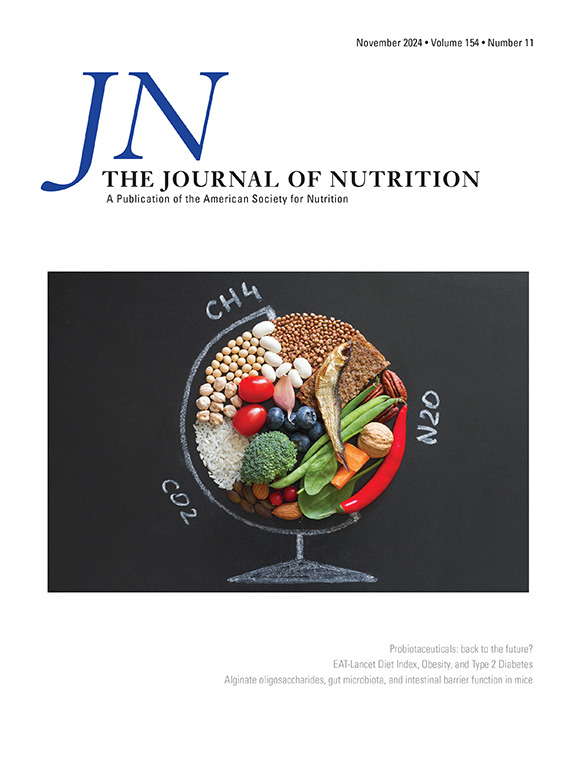Cross-Sectional Associations between Clinical Biochemistry and Nutritional Biomarkers and Sarcopenic Indices of Skeletal Muscle in the Baltimore Longitudinal Study of Aging
IF 3.7
3区 医学
Q2 NUTRITION & DIETETICS
引用次数: 0
Abstract
Background
Investigating relationships between nutritional and clinical biochemistry biomarkers and skeletal muscle mass, strength and function (sarcopenic indices) may 1) highlight micronutrients of interest for potential preventive or treatment strategies for sarcopenia, or 2) highlight biomarkers that may be useful for identifying individuals at risk of sarcopenia.
Objectives
Investigate associations between nutritional biomarkers (vitamin D, vitamin B12, folate, magnesium, potassium, calcium, and iron), clinical biomarkers (hemoglobin, ferritin, albumin, creatinine, and hemoglobin A1c: HbA1c), and sarcopenic indices (appendicular lean mass: ALM); height-adjusted ALM: ALMht; fat-free mass as a percentage of total body weight; extended short physical performance battery score: extSPPB; height-adjusted hand grip strength: HGSht; height-adjusted knee extension concentric strength, and; height-adjusted knee extension isometric strength) in males and females.
Methods
Using multivariable linear regression analysis, we investigated cross-sectional associations between biomarkers and sarcopenic indices in data collected from 1761 participants (age 22–103 y) from the Baltimore Longitudinal Study of Aging.
Results
Hemoglobin was positively associated with ALM (β = 0.20, P = 0.021), HGSht (β = 0.25, P = 0.001), and extSPPB (β = 0.13, P = 0.024) in males, and with extSPPB in females (β = 0.15, P = 0.019). In males, serum iron was positively associated with ALMht (β = 0.0021, P = 0.038) and extSPPB (β = 0.0043, P = 0.045). In females, ferritin was positively associated with knee-extension strength measurements. Serum creatinine was positively associated with lean mass measures in males and females and with muscle strength and function measures in males with normal renal function (estimated glomerular filtration rate 60 mL/min/1.73 m2). In males, high HbA1c was associated with lower ALMht (β = –0.21, P = 0.023), extSPPB (β = –0.40, P = 0.027), and HGSht (β = –0.56, P = 0.031). In males and females, magnesium was positively associated with extSPPB, and potassium was positively associated with measures of knee-extension strength.
Conclusions
The associations found between measures of iron status and creatinine and sarcopenic indices, in males in particular, indicate potential importance for muscle health. Future longitudinal and intervention studies are warranted to confirm these findings.
巴尔的摩衰老纵向研究中骨骼肌临床生化和营养生物标志物与肌肉减少指数的横断面关联。
背景:研究营养和临床生物化学标志物与骨骼肌质量、力量和功能(肌少指数)之间的关系可能:(i)突出对肌少症潜在预防或治疗策略感兴趣的微量营养素,或(ii)突出可能对识别肌少症风险个体有用的生物标志物。目的:研究营养生物标志物(维生素D、维生素B12、叶酸、镁、钾、钙、铁)、临床生物标志物(血红蛋白、铁蛋白、白蛋白、肌酐、糖化血红蛋白)与肌肉减少指数(阑尾瘦质量(ALM)、身高调节型瘦质量(ALMht)、体重无脂质量百分比(FFM%)、延长短时间物理性能电池评分(extSPPB))之间的关系。以及男性和女性的高度调整握力(HGSht)和膝关节伸展同心(KECht)和等距(KEIht)力量。设计:使用多变量线性回归分析,我们从巴尔的摩老龄化纵向研究(BLSA)收集的1,761名参与者(22-103岁)的数据中调查了生物标志物和肌肉减少指数之间的横断面关联。结果:血红蛋白与男性ALM (β=0.20, p=0.021)、HGSht (β=0.25, p=0.001)和extSPPB (β=0.13, p=0.024)呈正相关,与女性extSPPB (β=0.15, p=0.019)呈正相关。在男性中,血清铁与ALMht (β=0.0021, p=0.038)和extSPPB (β=0.0043, p=0.045)呈正相关。在女性中,铁蛋白与膝关节伸展强度测量呈正相关。血清肌酐与男性和女性的瘦质量呈正相关,与肾功能正常男性的肌肉力量和功能呈正相关(估计肾小球滤过率为60 mL/min/1.73m2)。在男性中,高HbA1c与ALMht (β=-0.21, p=0.023)、sppb (β=-0.40, p=0.027)和HGSht (β=-0.56, p=0.031)降低相关。在男性和女性中,镁与extSPPB呈正相关,钾与膝关节伸展强度呈正相关。结论:铁状态测量与肌酐和肌肉减少指数之间的关联,特别是在男性中,表明对肌肉健康的潜在重要性。未来的纵向和干预研究有必要证实这些发现。
本文章由计算机程序翻译,如有差异,请以英文原文为准。
求助全文
约1分钟内获得全文
求助全文
来源期刊

Journal of Nutrition
医学-营养学
CiteScore
7.60
自引率
4.80%
发文量
260
审稿时长
39 days
期刊介绍:
The Journal of Nutrition (JN/J Nutr) publishes peer-reviewed original research papers covering all aspects of experimental nutrition in humans and other animal species; special articles such as reviews and biographies of prominent nutrition scientists; and issues, opinions, and commentaries on controversial issues in nutrition. Supplements are frequently published to provide extended discussion of topics of special interest.
 求助内容:
求助内容: 应助结果提醒方式:
应助结果提醒方式:


